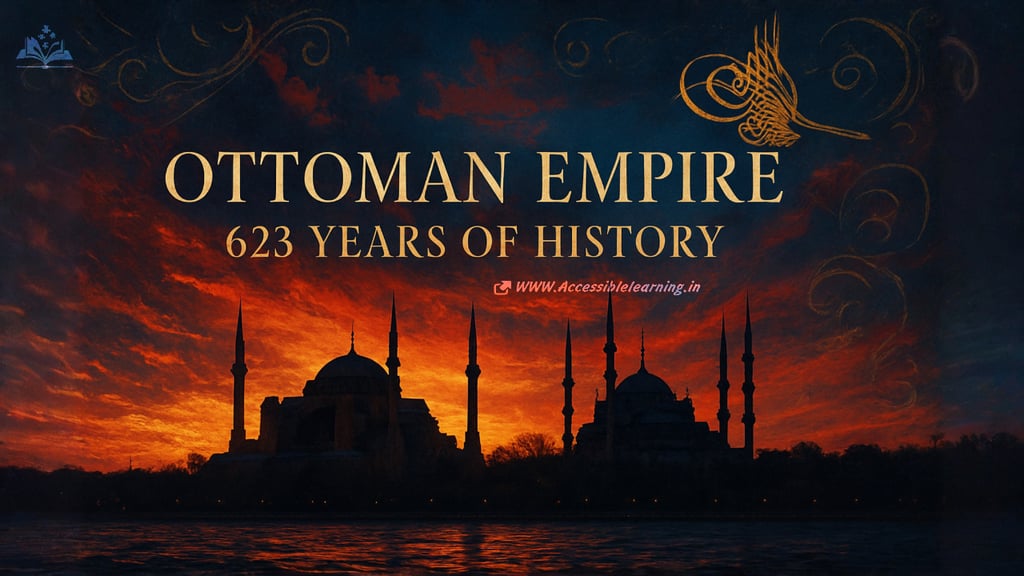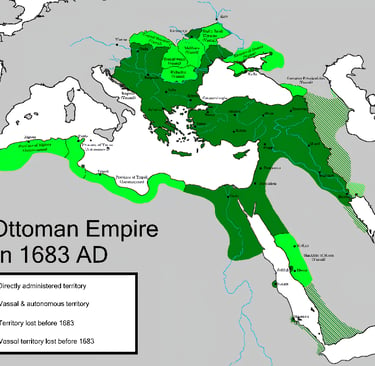
The Ottoman Empire: A Six-Century Journey from Beylik to Global Superpower (1299-1922)
Explore the comprehensive history of the Ottoman Empire (1299-1922), from its origins as a small Anatolian beylik to its transformation into a transcontinental superpower spanning three continents. This detailed analysis covers Ottoman military conquests, administrative innovations including the millet system, cultural achievements, economic foundations, and the complex factors leading to the empire's eventual dissolution after World War I. Discover how this six-century Islamic empire shaped modern geopolitics and continues to influence contemporary Middle Eastern, European, and North African affairs through its enduring political, architectural, and cultural legacy.
EMPIRES/HISTORYHISTORY
Kim Shin
8/16/20257 min read


The Ottoman Empire stands as one of history's most influential and enduring imperial powers, spanning six centuries and three continents. From its humble origins as a small beylik in northwestern Anatolia to becoming a transcontinental empire that shaped the political, cultural, and economic landscape of Southeast Europe, West Asia, and North Africa, the Ottoman legacy continues to influence modern geopolitics and international relations.
What Was the Ottoman Empire? Origins and Foundation
The Ottoman Empire, also known as the Turkish Empire, emerged from modest beginnings around 1299 when the Turkoman tribal leader Osman I established a small principality in northwestern Anatolia. This foundational period marks the beginning of what would become one of the longest-lasting empires in human history, eventually controlling vast territories across multiple continents for over six hundred years.
The empire's transformation from a petty kingdom to a global superpower represents one of the most remarkable examples of imperial expansion in world history. By the mid-14th century, Osman's successors had conquered substantial portions of Anatolia and begun their expansion into the Balkans, setting the stage for centuries of Ottoman dominance.
The Rise to Power: Ottoman Empire Expansion and Military Prowess
Early Conquests and Territorial Growth
The Ottoman Empire's expansion strategy combined military innovation, administrative efficiency, and cultural adaptation. During the 14th and 15th centuries, Ottoman forces systematically conquered Byzantine territories, establishing footholds in Europe that would prove crucial for future expansion.
The conquest of Constantinople in 1453 by Mehmed II marked a pivotal moment in both Ottoman and world history. This victory not only eliminated the last remnant of the Byzantine Empire but also established Ottoman control over one of the world's most strategically important cities, transforming it into Istanbul, the empire's magnificent capital.
Golden Age Under Suleiman the Magnificent
The 16th century witnessed the Ottoman Empire reach its zenith under Sultan Suleiman I, known as Suleiman the Magnificent in the West and Suleiman the Lawgiver in Ottoman territories. During his reign from 1520 to 1566, the empire expanded to its greatest territorial extent, stretching from Vienna to Cairo, encompassing much of the Mediterranean basin, and threatening the heart of Christian Europe.
This period saw significant military campaigns that brought Hungary, parts of Austria, and much of the Mediterranean under Ottoman control. The empire's naval power challenged Portuguese and Spanish dominance in the Indian Ocean, while its land forces repeatedly threatened Vienna, the gateway to Central Europe.
Ottoman Empire Government and Administrative System
The Millet System and Religious Tolerance
One of the Ottoman Empire's most distinctive features was its sophisticated administrative system, particularly the millet system, which governed non-Muslim populations. This system allowed various religious and ethnic communities to maintain their own laws, customs, and leadership structures while remaining loyal subjects of the Sultan.
The millet system enabled the Ottoman Empire to govern a remarkably diverse population spanning multiple continents, languages, and religious traditions. This administrative flexibility contributed significantly to the empire's longevity and stability, allowing it to maintain control over heterogeneous populations for centuries.
The Devshirme System and Janissary Corps
The Ottoman military's backbone was the Janissary corps, an elite infantry unit recruited through the devshirme system. This unique institution involved the systematic recruitment of Christian boys from Balkan provinces, who were converted to Islam and trained as soldiers and administrators. The system created a loyal military and administrative class directly answerable to the Sultan, bypassing traditional tribal and aristocratic power structures.


Economic Foundations: Trade, Agriculture, and Urban Development
Strategic Control of Trade Routes
The Ottoman Empire's economic prosperity derived largely from its strategic position controlling major trade routes between Europe, Asia, and Africa. The empire collected substantial revenues from customs duties, taxes on goods passing through its territories, and tribute from vassal states.
Recent research highlights the role of agricultural products like figs and raisins in promoting economic development, particularly in cities like Izmir, which became important gateway cities connecting Ottoman territories with European markets. This agricultural trade complemented the empire's control over luxury goods from Asia, creating a diversified economic base.
Urban Centers and Commercial Networks
Major Ottoman cities like Istanbul, Cairo, Damascus, and Baghdad developed into significant commercial and cultural centers. These urban environments fostered trade, craftsmanship, and intellectual exchange, contributing to the empire's cultural richness and economic vitality.
Cultural Legacy and Architectural Achievements
Ottoman Architecture and Engineering
Ottoman architecture represents a unique synthesis of Islamic, Byzantine, and Persian influences, creating a distinctive architectural style that remains influential today. The Süleymaniye Mosque in Istanbul, designed by the renowned architect Mimar Sinan, exemplifies the sophistication of Ottoman architectural achievement.
The empire's engineering capabilities extended beyond religious buildings to include bridges, aqueducts, caravanserais, and public baths that served both practical and social functions. These infrastructure projects facilitated trade, communication, and social cohesion across the vast Ottoman territories.
Literary and Artistic Contributions
Ottoman cultural achievements encompassed literature, poetry, music, and decorative arts. The empire fostered a rich intellectual tradition that incorporated influences from Arabic, Persian, and European cultures while developing distinctly Ottoman forms of expression.
The Decline and Fall: Factors Leading to Ottoman Empire Collapse
Internal Challenges and Reform Attempts
The empire had already been in decline for centuries, struggling to maintain a bloated bureaucracy or a centralized administrative structure after various attempts at reform. The 18th and 19th centuries witnessed numerous reform efforts, including the Tanzimat period, which attempted to modernize Ottoman institutions and legal systems.
These reform attempts, while ambitious, often faced resistance from traditional power structures and proved insufficient to address the empire's fundamental challenges. Economic difficulties, technological lag, and administrative inefficiencies accumulated over time, weakening the empire's ability to compete with European powers.
World War I and Final Dissolution
The Ottoman Empire's participation in World War I as part of the Central Powers proved to be its final chapter. The empire disintegrated and was partitioned after its defeat in World War I, with various territories distributed among the victorious Allied powers.
The Treaty of Sèvres in 1920 and subsequently the Treaty of Lausanne in 1923 formally ended the Ottoman Empire and established the modern Turkish Republic under Mustafa Kemal Atatürk. This transition marked the end of over six centuries of Ottoman rule and the beginning of a new era in Turkish history.
Ottoman Empire Timeline: Key Dates and Events
The Ottoman chronology spans from its founding in 1299 to its dissolution in 1922, encompassing numerous significant events that shaped both the empire and the broader historical narrative of Europe, Asia, and Africa.
Major milestones include the conquest of Constantinople in 1453, the Battle of Lepanto in 1571, the failed siege of Vienna in 1683, the beginning of the Tanzimat reforms in 1839, and the Young Turk Revolution in 1908. Each of these events represents crucial turning points in Ottoman history and their broader regional impact.
Modern Relevance: Ottoman Empire Legacy in Contemporary Politics
Historical Memory and National Identity
The Ottoman legacy continues to influence contemporary politics and national identity formation across the former Ottoman territories. Modern Turkey, in particular, has experienced renewed interest in its Ottoman heritage, with political leaders occasionally invoking Ottoman symbolism and historical narratives.
Recent scholarly research examines how status symbols rise and fall within historical contexts, including Ottoman religious and cultural symbols that continue to resonate in contemporary society. This research provides insights into how historical legacies shape modern political and cultural discourse.
Academic Research and New Perspectives
Contemporary Ottoman studies benefit from interdisciplinary approaches that incorporate environmental history, economic analysis, and cultural studies. Current academic programs focus on understanding the cultural and historical processes leading to the formation and development of the Ottoman Empire, emphasizing its interactions with Western Christendom, Islam, Byzantium, and Central Asia.
Recent publications examine various aspects of Ottoman history, including livestock trade, scientific developments, and social structures, providing new insights into the empire's complex legacy and its continuing relevance for understanding modern geopolitical dynamics.

FAQ's
Q: How long did the Ottoman Empire last?
The Ottoman Empire lasted approximately 623 years, from its founding around 1299 to its dissolution in 1922 following World War I.
Q: What was the largest extent of the Ottoman Empire?
At its peak in the 16th century, the Ottoman Empire controlled territories spanning three continents, from southeastern Europe through Western Asia to North Africa, including modern-day Turkey, Greece, Bulgaria, Egypt, Syria, and parts of Hungary and Austria.
Q: Why did the Ottoman Empire fall?
The Ottoman Empire's decline resulted from multiple factors, including administrative inefficiency, economic challenges, military technological lag, nationalist movements within the empire, and ultimately its defeat in World War I.
Q: What was the Ottoman Empire's religion?
The Ottoman Empire was officially an Islamic state, with Sunni Islam as the dominant religion. However, the millet system allowed religious minorities, including Christians and Jews, to practice their faiths and maintain their communities.
Q: What language did the Ottoman Empire speak?
Ottoman Turkish served as the empire's administrative and literary language, incorporating vocabulary from Arabic, Persian, and Turkish. However, the empire was multilingual, with various communities speaking their native languages.
Q: What happened to Ottoman territories after the empire's fall?
Former Ottoman territories were divided among various successor states and mandates, including modern-day Turkey, Syria, Iraq, Jordan, Israel/Palestine, Lebanon, and parts of the Arabian Peninsula, with some territories assigned to European mandates.
The Ottoman Empire's six-century span represents one of history's most successful examples of multi-ethnic, multi-religious imperial governance. Its sophisticated administrative systems, military innovations, and cultural achievements continue to influence contemporary scholarship and political discourse.
The empire's legacy extends beyond historical curiosity to provide valuable insights into imperial governance, cultural synthesis, and the complex processes of imperial rise and decline. As modern scholars continue to explore Ottoman history through new methodological approaches, our understanding of this remarkable empire and its continuing relevance continues to evolve.
The Ottoman Empire's transformation from a small Anatolian beylik to a transcontinental superpower, and its eventual dissolution into the modern state system, offers crucial lessons for understanding imperial dynamics, cultural exchange, and the forces that shape historical change. Its story remains essential for comprehending the complex historical foundations of the modern Middle East, Balkans, and Eastern Mediterranean regions.
Subscribe To Our Newsletter
All © Copyright reserved by Accessible-Learning Hub
| Terms & Conditions
Knowledge is power. Learn with Us. 📚


